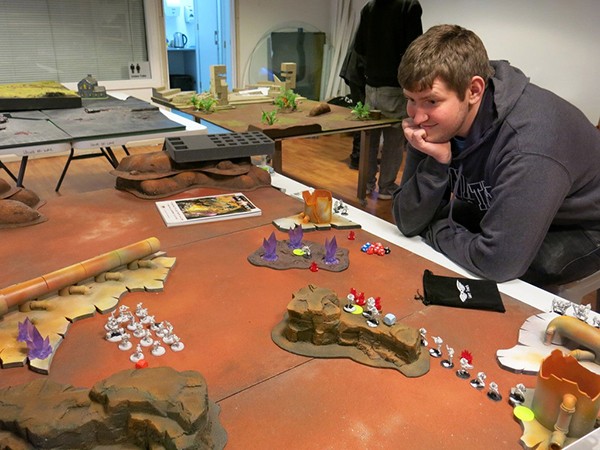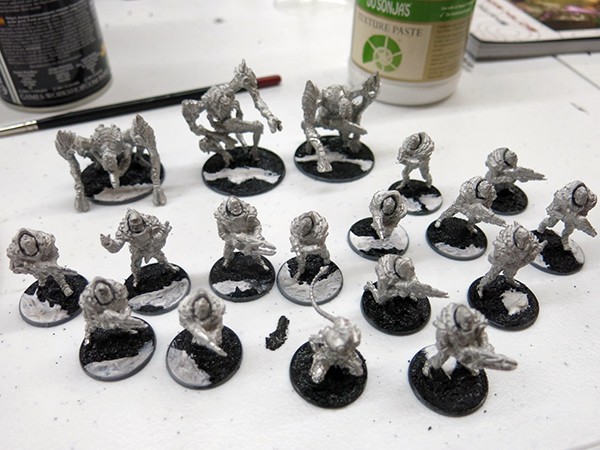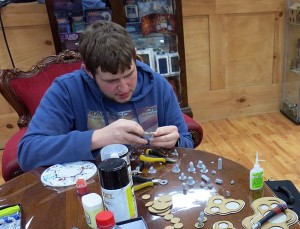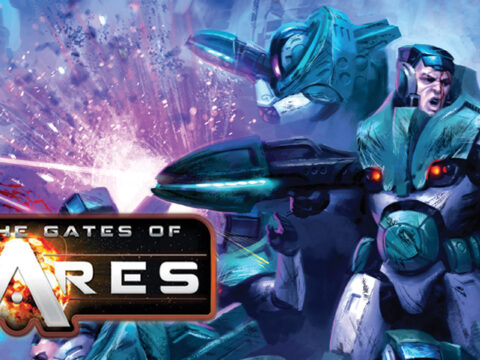Selected for the Antares Initiative Noise Sector is a band of opportunistic hobby corsairs plying their trade across time, space, dimensions and systems using MAXIMUM VOLUME!!!
By Mitch Thomas
Hello all, Mitchell Thomas from the Noise Sector here reporting in from Australia and I’m back again this time to talk about the planet Defor and how I painted my Isorians. When we first were accepted into the Antares Initiative Ash, Dan, Mick and myself were already brainstorming ideas for a table and having discussions on what we would do for paint schemes. Our initial thoughts were that we wanted to have a Jungle board with plenty of opportunity for some crazy paint schemes (I think Dan at one stage was talking about painting his C3 a bright metallic pink). It was around this time that we heard whispers of something absolutely amazing. The man, the myth, the legend, Rick Priestly himself was going to be designing four planets for the eight groups to be allocated to and to fight over and that the planets themselves are now in the Beyond the Gates of Antares story. This was a massive thing for me and I waited tentatively as we all awaited the designs for the planet our armies were going to be calling home for the next 6 months. Then the announcement came and were given our planets. We were given the death world… Defor…
Now Defor isn’t your regular everyday planet. As I said before Defor is a death world. Comparing it to a modern continent we were essentially given Australia the planet. If the opposing forces on Defor wasn’t enough to kill you then the planet surely will. With it’s extremely acidic atmosphere, seas of boiling tar that exude an acidic khaki coloured cloud, and it’s thin red sand crust which gives way to even more tar hiding underneath Defor was very quickly dismissed as being a useful planet to colonise. This harsh forsaken planet only has one indigenous species which aren’t exactly the most natural of aliens. The Deforan’s bodies are crystalline and take the appearance of naturally occurring minerals. The are rooted in place and their only real way of moving, if you can even call it that, is to grow outwards in directions. The grow in groves where the more stable surface of Defor is found. Only some of these large crystal structures are sentient and communication is difficult to say the least.

It was a planet that was ignored by most when first discovered and it wasn’t until a Vorl fleet recently decided to raid the hellish planet. At first rampaging at will on the planet against the seemingly defenceless Deforans their entire fleet was destroyed when vast balls of molten plasma rising from the boiling tar oceans wiped out the Vorl fleet in it’s entirety. This sparked an interest in the planet. Very quickly Defor had become a centre of attention and was very quickly covered in hostiles. The Deforans had somehow made an alliance of sorts with the Concord as the forces of the Ghar descend on the planet. The Algoryn fearing an attack from the Ghar deploy forces to the planet in order to protect some of their more undefended planets that are within easy reach of Defor. And the glory that is the Isorian Senatex also had remote worlds within attacking distance of Defor.
What a story Rick Priestly has put together for us, we’re determined to do Defor justice. So after a couple of meetings with the Noise Sector we each knew what we were going to do to bring Defor to life on the tabletop. While Ash, Dan and Mick had all decided to really show the dangerous environment of Defor by modelling onto their models the wear and tare that their forces had all sustained.
I opted for a different option. I prefer my models to be clean to an extent which didn’t really work with the planet we had been given. So I came back to my original idea that I had for when we originally were discussing what we were going to do for our planet. I thought instead of having Defor show it’s acidic atmosphere on my models I’ll have my models adapt to their surroundings. That’s why I decided to go for a camouflage effect on my Isorians like I was originally planning to do for the jungle planet that we thought up when we were first accepted into the Antares Initiative. This made me to take some time to think about how I wanted to execute my paint scheme as we had already discussed what we were doing for bases and I really needed them to stand out from the bases as the colours were very similar to what I was planning. I also needed to think of some other colours to mix into the model as I didn’t really want mono-coloured models and as a rule of thumb I believe three colours hits the perfect spot for variety in your models.

So I took a brief moment to inspect a single member of one of the phase squads. The things that stood out for me were obviously the armour, the vents found around the armour, the helmet and the gun. So I figured that these were the areas that I would be painting differently from each other.
I started with the armour as it was the most obvious starting point for me being the biggest thing and obviously the thing you’re going to be looking at the majority of the time and once I had the colours for that I could progress and decide upon my rest of the colours once I was happy with the armour. I originally was going for a much darker colour then what I ended up with as I was struggling to get the models to stand out from the base. My progression for the armour ended up being as follows:
1. Base coat with Citadel Mournfang Brown
2. Wash lightly with a 1:1 mix of Citadel Baal Red and Citadel Devlan Mud
3. Drybrush with Citadel Wild Rider Red
4. Drybrush with Citadel Jokaero Orange
5. Drybrush with Citadel Fire Dragon Bright
6. Shade the recesses with a light wash of Citadel Badab Black
7. Highlight the fine edges with Citadel Fire Dragon Bright
With the armour done to a point where I’m happy with it standing out from the base I move on to the next area that needed attention, the vents. The vents were relatively easy to paint and very simple if not for the fact that some of them were hard to reach.
1. Base coat with Citadel Kantor Blue
2. Highlight with Citadel Alaitoc Blue
3. Highlight with Citadel Hoeth Blue
4. Highlight with Citadel Skull White
5. Fix up any mistakes/add further shading with a 1:1 mix of Citadel
Happy with the vents I moved onto the masks. I personally love the look of the white masks on the box art of the Isorians so I decided to go with a similar colour with a reddish shade to it so that it blends into the armour better.
1. Base coat with Citadel Dawnstone
2. Wash lightly with a 1:1 mix of Citadel Baal Red and Citadel Devlan Mud
3. Layer with Citadel Dawnstone
4. Mix in some Citadel Skull White with the Dawnstone used in the last step and continue layering.
5. Continue gradually adding white until the masks look more white then grey
6. Do a final highlight of Citadel Skull White on the edges of the mask and on their raised areas.
And last but not least I painted their guns. I originally struggled with what I was going to paint them as it was hard to find a balance between the bright orange of the armour and the blue of the vents. I originally tried a dark green but I wasn’t happy with the results and the colour really didn’t work with the rest of the models so I switched to a dark grey.
1. Base coat with Citadel Chaos Black
2. Drybrush with Citadel Mechanicus Standard Grey
3. Highlight with Citadel Mechanicus Standard Grey
4. Highlight with Citadel Dawnstone focusing on the corners and raised areas
Check out their month 2 antics in these 3 articles, a Podcast, and with updates over on their Facebook page:




